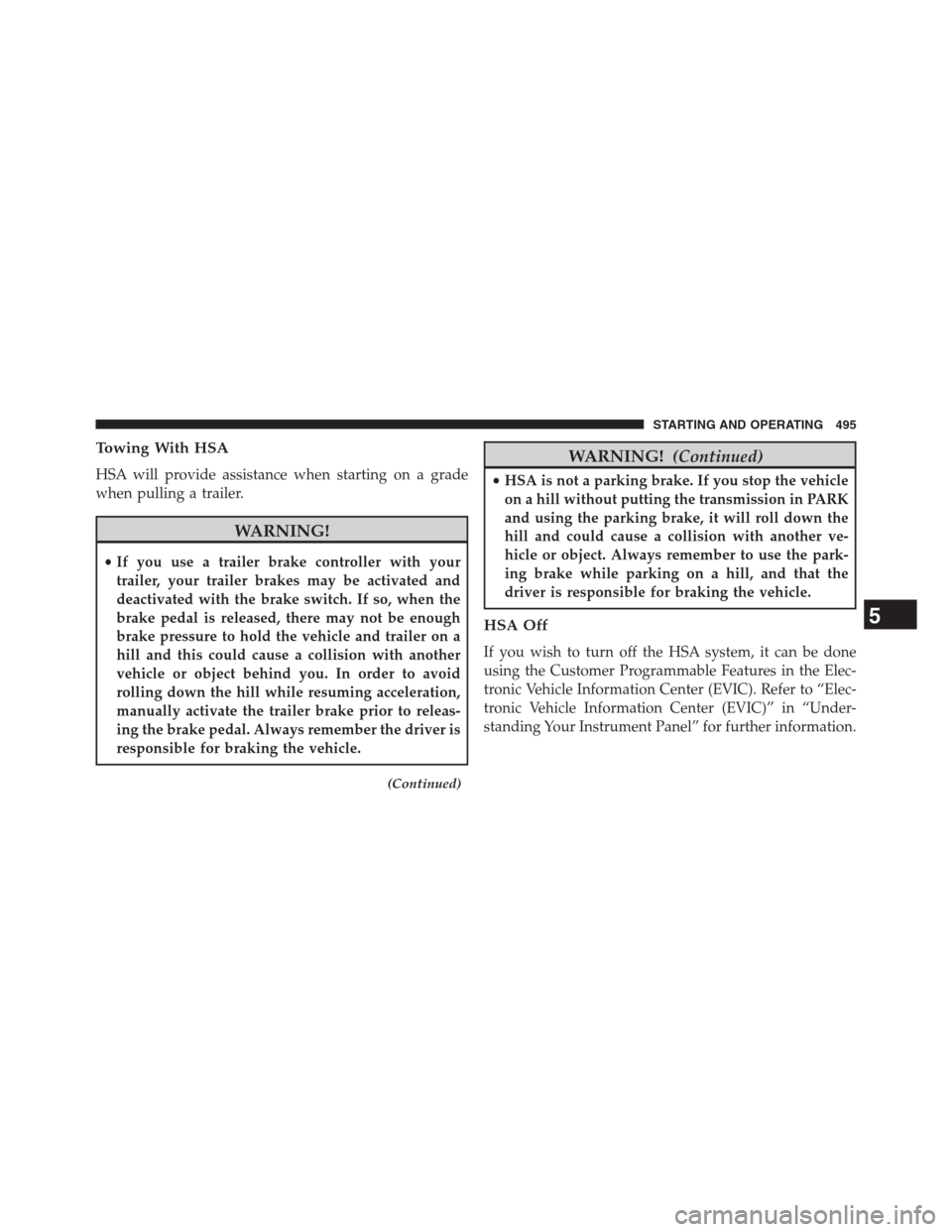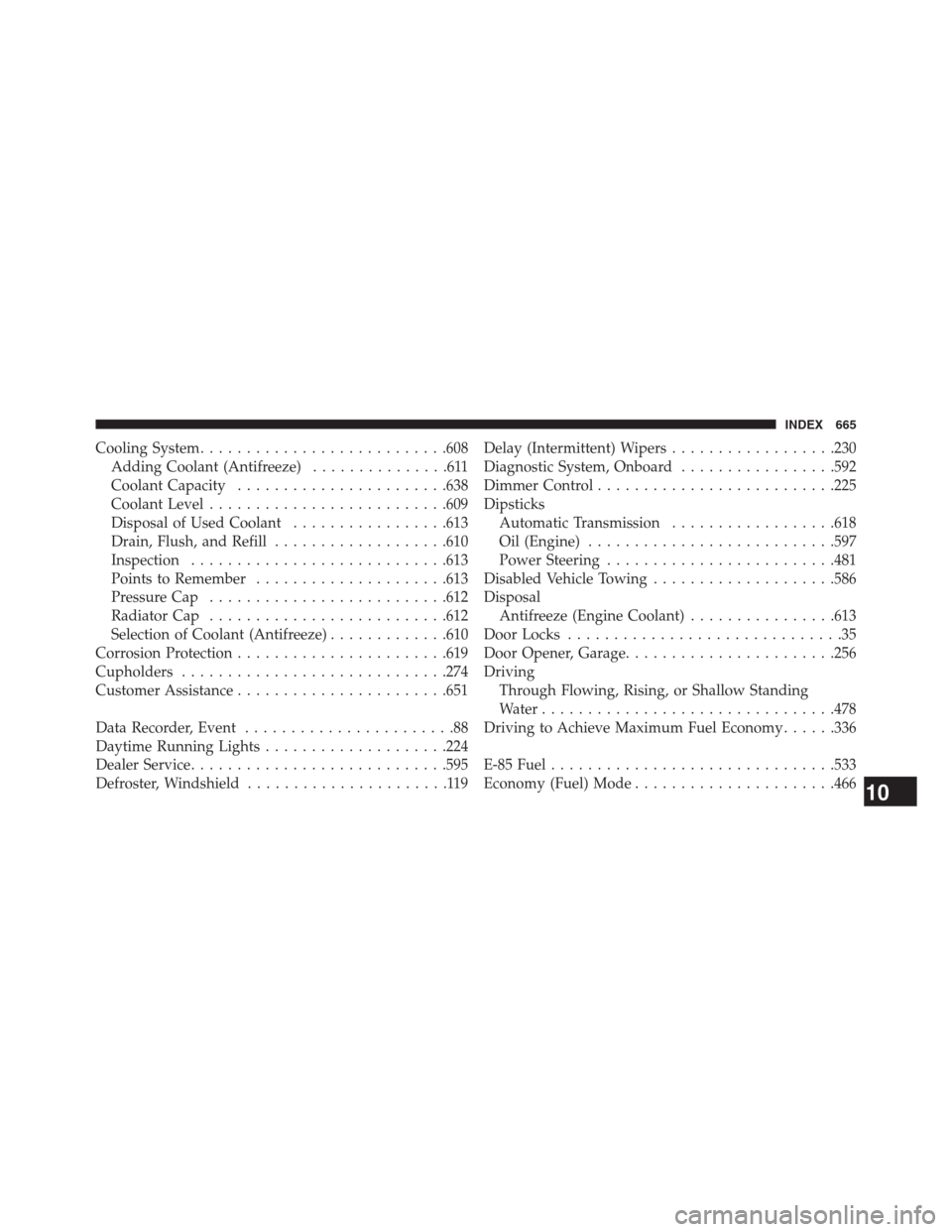2013 DODGE GRAND CARAVAN Transmission pressure
[x] Cancel search: Transmission pressurePage 497 of 683

Towing With HSA
HSA will provide assistance when starting on a grade
when pulling a trailer.
WARNING!
•If you use a trailer brake controller with your
trailer, your trailer brakes may be activated and
deactivated with the brake switch. If so, when the
brake pedal is released, there may not be enough
brake pressure to hold the vehicle and trailer on a
hill and this could cause a collision with another
vehicle or object behind you. In order to avoid
rolling down the hill while resuming acceleration,
manually activate the trailer brake prior to releas-
ing the brake pedal. Always remember the driver is
responsible for braking the vehicle.
(Continued)
WARNING!(Continued)
•HSA is not a parking brake. If you stop the vehicle
on a hill without putting the transmission in PARK
and using the parking brake, it will roll down the
hill and could cause a collision with another ve-
hicle or object. Always remember to use the park-
ing brake while parking on a hill, and that the
driver is responsible for braking the vehicle.
HSA Off
If you wish to turn off the HSA system, it can be done
using the Customer Programmable Features in the Elec-
tronic Vehicle Information Center (EVIC). Refer to “Elec-
tronic Vehicle Information Center (EVIC)” in “Under-
standing Your Instrument Panel” for further information.
5
STARTING AND OPERATING 495
Page 585 of 683

8. Disconnect the opposite end of the positive(+)jumper
cable from the positive(+)post of the booster battery.
9. Disconnect the positive(+)end of the jumper cable
from the positive(+)post of the discharged vehicle.
If frequent jump-starting is required to start your vehicle
you should have the battery and charging system in-
spected at your authorized dealer.
CAUTION!
Accessories plugged into the vehicle power outlets
draw power from the vehicle’s battery, even when not
in use (i.e., cellular phones, etc.). Eventually, if
plugged in long enough without engine operation,
the vehicle’s battery will discharge sufficiently to
degrade battery life and/or prevent the engine from
starting.
FREEING A STUCK VEHICLE
If your vehicle becomes stuck in mud, sand or snow, it
can often be moved using a rocking motion. Turn the
steering wheel right and left to clear the area around the
front wheels. Then shift back and forth between DRIVE
and REVERSE while gently pressing the accelerator. Use
the least amount of accelerator pedal pressure that will
maintain the rocking motion, without spinning the
wheels or racing the engine.
CAUTION!
Racing the engine or spinning the wheels may lead to
transmission overheating and failure. Allow the en-
gine to idle with the transmission in NEUTRAL for at
least one minute after every five rocking-motion
cycles. This will minimize overheating and reduce
the risk of transmission failure during prolonged
efforts to free a stuck vehicle.
6
WHAT TO DO IN EMERGENCIES 583
Page 644 of 683

MAINTENANCE SCHEDULE
Your vehicle is equipped with an automatic oil change
indicator system. The oil change indicator system will
remind you that it is time to take your vehicle in for
scheduled maintenance.
Based on engine operation conditions, the oil change
indicator message will illuminate. This means that ser-
vice is required for your vehicle. Operating conditions
such as frequent short-trips, trailer tow, extremely hot or
cold ambient temperatures, and E85 fuel usage will
influence when the “Oil Change Required” message is
displayed. Severe Operating Conditions can cause the
change oil message to illuminate as early as 3,500 miles
(5,600 km) since last reset. Have your vehicle serviced as
soon as possible, within the next 500 miles (805 km).
Your authorized dealer will reset the oil change indicator
message after completing the scheduled oil change. If a
scheduled oil change is performed by someone other thanyour authorized dealer, the message can be reset by refer-
ring to the steps described under “Electronic Vehicle Infor-
mation Center (EVIC)/Oil Change Required” in “Under-
standing Your Instrument Panel” for further information.
NOTE:Under no circumstances should oil change inter-
vals exceed 10,000 miles (16,000 km) or twelve months,
whichever comes first.
Once A Month Or Before A Long Trip:
•Check engine oil level
•Check windshield washer fluid level
•Check the tire inflation pressures and look for unusual
wear or damage
•
Check the fluid levels of the coolant reservoir, brake
master cylinder, power steering and transmission as
needed
•Check function of all interior and exterior lights
8
M
A
I
N
T
E
N
A
N
C
E
S
C
H
E
D
U
L
E
S642 MAINTENANCE SCHEDULES
Page 665 of 683

Automatic Transmission....................464
Adding Fluid..........................618
Fluid and Filter Changes..................618
Fluid Change..........................618
Fluid Level Check.......................618
Fluid Type............................617
Gear Ranges...........................469
Special Additives.......................617
Torque Converter.......................476
Auto Up Power Windows....................42
Battery.................................603
Jump Starting..........................579
Keyless Transmitter Replacement (RKE)........28
Saving Feature (Protection)................228
Belts, Seat...............................118
Blind Spot Monitoring......................136
Body Mechanism Lubrication.................607
B-Pillar Location..........................502Brake Assist System.......................487
Brake Control System, Electronic..............486
Brake Fluid.............................640
Brake System............................615
Fluid Check...........................615
Parking..............................481
Warning Light.........................320
Brake/Transmission Interlock.................466
Bulb Replacement.........................635
Bulbs, Light.............................120
Calibration, Compass......................340
Camera, Rear............................249
Capacities, Fluid..........................638
Caps, Filler
Fuel.................................537
Power Steering.........................481
Radiator (Coolant Pressure)................612
Carbon Monoxide Warning
..................11710
INDEX 663
Page 667 of 683

Cooling System...........................608
Adding Coolant (Antifreeze)...............611
Coolant Capacity.......................638
Coolant Level..........................609
Disposal of Used Coolant.................613
Drain, Flush, and Refill...................610
Inspection............................613
Points to Remember.....................613
Pressure Cap..........................612
Radiator Cap..........................612
Selection of Coolant (Antifreeze).............610
Corrosion Protection.......................619
Cupholders.............................274
Customer Assistance.......................651
Data Recorder, Event.......................88
Daytime Running Lights....................224
Dealer Service............................595
Defroster, Windshield......................119Delay (Intermittent) Wipers..................230
Diagnostic System, Onboard.................592
Dimmer Control..........................225
Dipsticks
Automatic Transmission..................618
Oil (Engine)...........................597
Power Steering.........................481
Disabled Vehicle Towing....................586
Disposal
Antifreeze (Engine Coolant)................613
Door Locks..............................35
Door Opener, Garage.......................256
Driving
Through Flowing, Rising, or Shallow Standing
Water................................478
Driving to Achieve Maximum Fuel Economy......336
E-85 Fuel...............................533
Economy (Fuel) Mode......................466
10
INDEX 665